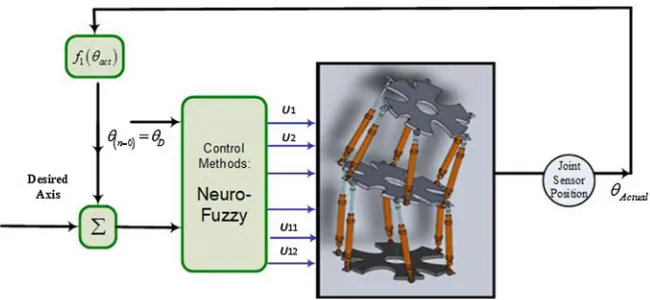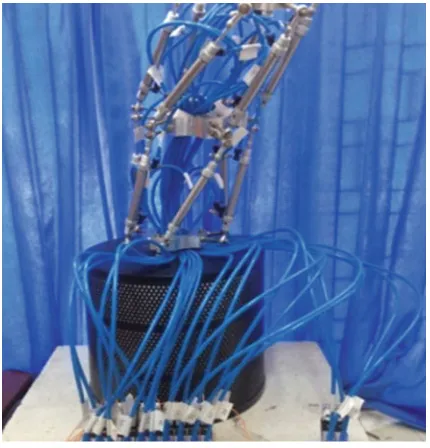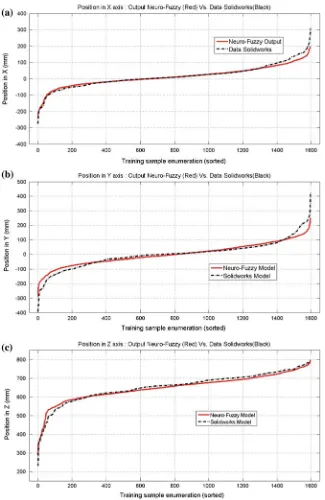Coordinates Modelling of the Discrete
Hexapod Manipulator via Arti
fi
cial
Intelligence
Felix Pasila and Roche Alimin
Abstract This paper will present how to model the XYZ coordinates of a Discrete Manipulator with two-six discrete pneumatic actuators via artificial intelligence algorithm (AI) efficiently. The XYZ model is said efficient if mathematical calcu-lation of the discrete states of manipulator related to XYZ coordinates, with the inverse static analysis (ISA) problem, can be approximately done via AI. The research method used simulation software and hardware implementation with the case of massive manipulator with two level discrete actuators. Simulations with typical desired displacement inputs are presented and a good performance of the results via AI is obtained. The comparison showed that the parallel manipulator has the Root Mean Squared (RMS) error less than 2 %.
Keywords Discrete manipulator
Artificial intelligence algorithmInverse static analysis problem4.1
Introduction
Discrete manipulator (DM) is a manipulator that consists of a number of actuators which are arranged in serial and/or parallel. In general, DM mechanism consists of a combination of joints, where the actuators can move and serve the manipulator like a prismatic joint. DM has been developed for a wide range of applications such as motion simulators and bio-mechanic applications.
To achieve variation range and accuracy, the architecture of DM practically requires a large number of discrete actuators that can be arranged in a hybrid series-parallel configuration. In designing a DM, the Jacobian matrix method is proposed in determining actuator states of the DM. However, this method has its
F. Pasila (&)R. Alimin
Department of Electrical Engineering, Petra Christian University, Surabaya, Indonesia
e-mail: [email protected]
©Springer Science+Business Media Singapore 2016
F. Pasila et al. (eds.),Proceedings of Second International Conference on Electrical Systems, Technology and Information 2015 (ICESTI 2015), Lecture Notes in Electrical Engineering 365, DOI 10.1007/978-981-287-988-2_4
disadvantages because Jacobian matrix can only control a few number of actuators. One method to overcome the complexity of the solutions that have been proposed to overcome the limitations of the Jacobian matrix in designing DM is using Inverse Static Analysis (ISA) [1], where one of the ISA solution is using AI [2].
A DM, which the actuators are assigned with a limited number of state, is intended to reduce the complexity of the mechanism and to develop a manipulator without sensors [1]. Several solution of using DM in the sense of ISA Problem, such as: exhaustive search mechanism via brute-force [3]; differential geometry and variation of calculus [4]; combinatorial of heuristics computation [5, 6]; genetic algorithm methods [7]; probability theory and computation [8]; Hopfield networks and Boltzmann machines algorithms [3]. Even though most of the proposed solu-tion methods are relatively effective in reducing problem complexity (from expo-nential to polynomial time), the resulting of proposed solutions still have slow calculations in terms of real-time computation.
Previous studies which are closely linked to the control of DM using artificial intelligence was conducted by Pasila [2]. This study focused on controlling the 6 DOF parallel manipulator using neuro-fuzzy method. The parallel manipulators used in this research have more than six prismatic actuator with Spherical-Prismatic-Spherical -3D mechanism. Results obtained from this study is that the parallel manipulator twisted due to the way the actuators are arranged and still have big error in terms of RMS.
The goal of this research is to design a two-level discrete manipulator for bio-mechanical purposes with 12 discrete actuator. Here, the ISA solution uses Neuro-Fuzzy network. The second objective is to obtain a state approximation for each actuator to obtain efficient results with Root Mean Square (RMS) error of less than 5 %.
4.2
Research Methodology
4.2.1
Design of the Discrete Manipulator
determined to be double-six or 12 actuators. In order to determine the position of each actuator, a novel parallel manipulator was implemented which based on hexapod Stewart-Gough platform [9].
4.2.2
Generating Data via SW Software
Data gathering was done via software simulation SW software, by measuring the position of a selected point on the upper platform. The motion simulation generates 1596 data, where each the data consists of coordinates along X, Y, and Z axis along with the combined states on the moving platform. Some of the extracted data can be seen in Table4.1.
4.2.3
Neuro-Fuzzy network as AI Method
This sub-section presents the diagram of the considered model, like shown in Fig.4.1. The architecture, has three inputs (desired axises) and 12 outputs (actuator states), is called as feedforward Neuro-Fuzzy type Takagi-Sugeno [10].
In particular, the control method presents the Gaussian membership functionsGjn
(j= 1, 2, 3;n= 1,…, 12), as a fuzzyfication variable for input pairsZ= [Rx, Ry,Rz],
Table 4.1 Selected data of two-six hexapod mechanism (1 = extend, 0 =floating, -1 = retract)
Lower Manipulator States Upper Manipulator States Axis Coordinates
S1 S2 S3 S4 S5 S6 S7 S8 S9 S10 S11 S12 X Y Z
0 0 1 1 0 0 1 0 -1 -1 0 1 6 24 627
0 0 1 1 0 0 1 1 0 -1 -1 0 6 27 623
0 0 0 1 1 0 1 0 -1 -1 0 1 -85 -83 574
0 0 0 0 1 1 0 1 1 0 -1 -1 -18 -4 628
0 1 1 0 -1 -1 0 1 0 1 0 0 50 15 707
-1 -1 0 1 1 0 1 0 -1 -1 0 1 -9 19 623
-1 -1 0 1 1 0 -1 0 1 1 0 -1 9 51 574
1 1 0 -1 -1 0 1 0 -1 -1 0 1 10 -22 627
-1 0 1 1 0 -1 1 1 0 -1 -1 0 -11 -12 619
whereRx, Ry,Rzare the input set of the orientations with respect to the XYZ Euler
j and variance rnj together with the corresponding fuzzy rulesFR
n
optimized rules for the model, here M = 6) being the Takagi-Sugeno parameters.
Equations (4.3), (4.4) are derived by approximating the actuator activation statesui.
through possible states (+1, 0 or −1) via threshold processes. These give the
actuator states as approximated solution.
4.3
Results and Discussions
In this paper, the data simulation is generated from the 3D SW software. At this point, Figs.4.2and4.3show the implementation of the discrete manipulator with 12 actuators along with the graphs of data simulation results and their neuro-fuzzy model respectively. The total dataset for model use 1596 data which are already selected and sorted from the smallest to the largest value.
Moreover, Fig. 4.3 describes the comparison between the simulation results obtained with the SW software, which shows the approximate value when the actuator is discretely controlled. In addition, it can be seen that the position along X, Y and Z axis closely have generated similar value compared to the continuous controller form. As a result, the RMS error of coordinates modeling in X, Y and Z are 1.43, 1.34 and 1.75 % respectively. The total performance has, in average, 1.51 % of RMS error.
4.4
Conclusions
As conclusion, this paper presented: (1) twelve discrete actuators two-six three-state discrete actuators with six DOF; (2) Neuro-Fuzzy methods type Takagi Sugeno for the solution of inverse static analysis of the considered manipulator. The prediction of the XYZ coordinates and its relevant states via neuro-fuzzy methods is used as control mechanism for the 12 actuators manipulator. The simulation result obtained using SW software shows that the reference point on the moving platform can move along the X, Y, and Z axis, which indicated the position of the point along each axis. RMS error of the manipulator obtained by comparing software simulation data and the results of neuro-fuzzy method shows quite small values on the X, Y and Z axis, which are less than 2 % Therefore it is most likely that neuro-fuzzy network can be used as an ISA solution on this manipulator.
Acknowledgments We would like to thank Ministry of Research, Technology and Higher Education of Indonesia for supporting this research under two years Research Grant 2014-2015, with the Number: 25/SP2H/LPPM-UKP/IV/201.
References
1. Pasila, F.: Inverse static analysis of massive parallel arrays of three-state actuators via artificial intelligence. PhD Dissertation, University of Bologna (2013)
2. Pasila, F., Alimin, R.: Neuro-fuzzy architecture of the 3D model of massive parallel actuators. ARPN J. Eng. Appl. Sci.9(12) (2014)
3. Yang, P., Waldron, K.J.: Massively parallel actuation. In: 2001 IEEE/ASME International Conference on Advanced Intelligent Mechatronics, pp. 868–873 (2001)
4. Chirikjian, G.S.: Inverse kinematics of binary manipulators using a continuum model. J. Intell. Rob. Syst.19, 5–22 (1997)
5. Lees, D.S., Chirikjian G.S.: A combinatorial approach to trajectory planning for binary manipulators. In: Proceedings of the 1996 IEEE International Conference on Robotics and Automation, pp. 2749–2754 (1996)
6. Sujan, V.A., Lichter D., Dubowsky S.: Lightweight hyper-redundant binary elements for planetary exploration robots. In: 2001 IEEE/ASME International Conference on Advanced Intelligent Mechatronics, pp. 1273–1278 (2001)
7. Lichter, D., Sujan V.A., Dubowsky S.: Computational issues in the planning and kinematics of binary robots. In: Proceedings of the 2002 IEEE International Conference on Robotics and Automation, pp. 341–346 (2002)
8. Suthakorn, J., Chirikjian, G.S.: A new inverse kinematic algorithm for binary manipulators with many actuators. Adv. Robot.15(2), 225–244 (2001)
9. Ioannis, D., Papadopoulos, E.: Model-based control of a 6-dof electrohydraulic Stewart-Gough platform. Mech. Mach. Theory43, 1385–1400 (2008)


